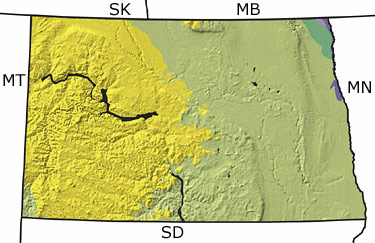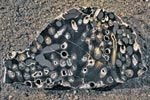North Dakota, US
|
|
|||||||||||||||||||||||||||||||||||||||||||||||||||||||||||||
Paleontology and geology
The Precambrian: There are subsurface Precambrian basement rocks in North Dakota, some of which are 2.6 billion years old. These rocks are mostly igneous and metamorphic and do not contain fossils.
The Paleozoic: The Paleozoic was a time of fluctuating sea levels. Shallow warm oceans covered much of North Dakota during most of the Early Paleozoic, and a diverse assemblage of invertebrate animals inhabited the marine environments. The oceans receded for a short time in the Late Silurian, but soon returned, flooding the land and depositing additional marine sediments. The rocks formed from these deposits contain fossils of corals, brachiopods, molluscs, and fish. The shallow oceans advanced and receded over the area more than once in the Middle Paleozoic, and alternating marine and non-marine conditions persisted into the Carboniferous and Permian. Toward the end of the Paleozoic, North Dakota lay near the equator. The seas that had periodically covered the state became progressively shallower and at times dry land was exposed.
The Mesozoic: North Dakota was hot and very dry during the Triassic, and shallow marine environments were common. The climate became subtropical in the Jurassic and low-lying, forested plains developed, but were soon replaced once again by shallow seas. Fossils of gastropods, bivalves, echinoderms, and foraminifera are found in the rocks formed on the floor of this sea. During the Cretaceous, North Dakota was either completely or partially covered by subtropical to temperate, shallow seas. The fossil remains of marine reptiles, fish, birds, and invertebrates are found in the marine deposits, while rocks formed along the coast of the sea contain the fossils of dinosaurs and other land and freshwater organisms.
The Cenozoic: During the Cenozoic, there were major climate changes in North Dakota. In the Tertiary, subtropical, swampy lowlands provided habitats for many kinds of terrestrial vertebrates as well as freshwater freshwater fish, molluscs and crustaceans. Ferns, cycads, figs, dawn redwoods, and palms grew in the lush forests. Decaying vegetation in the swamps was transformed eventually into lignite coal. As the climate became cooler and drier, the swampy environments and the plants and animals that lived in them began to disappear and were replaced by woodlands. The cooling trend continued during the Quaternary, and ice sheets advanced and retreated across the state. Fossils of mammoths, mastodons, and other large mammals are found.
Links to more on North Dakota paleontology
Organizations | Education and Exhibits | Resources
OrganizationsEducation and ExhibitsSocieties and Clubs (showing 1 of 1 listings)
North Dakota Geological Survey Fossil Resource Program: Links to all varieties of information on North Dakota paleontology, including research papers, museums, and background information on the state's fossils.
Museums (showing 1 of 1 listings)
The Pioneer Trails Regional Museum: Located in Bowman, North Dakota, PTRM hosts exhibits about local Cretaceous, Paleocene, and Eocene fossils. This museum also has an active research program.
ResourcesVirtual Exhibits (showing 1 of 1 listings)
When Crocodiles Ruled: An interactive journey through the Paleocene of North Dakota, shortly after the dinosaurs died out.
Field Guides (showing 1 of 1 listings)
Oceans of Kansas: Photographs, artwork, historical papers, and other information on the sea creatures, especially mosasaurs and plesiosaurs, that lived in the Western United States during the Cretaceous period.

